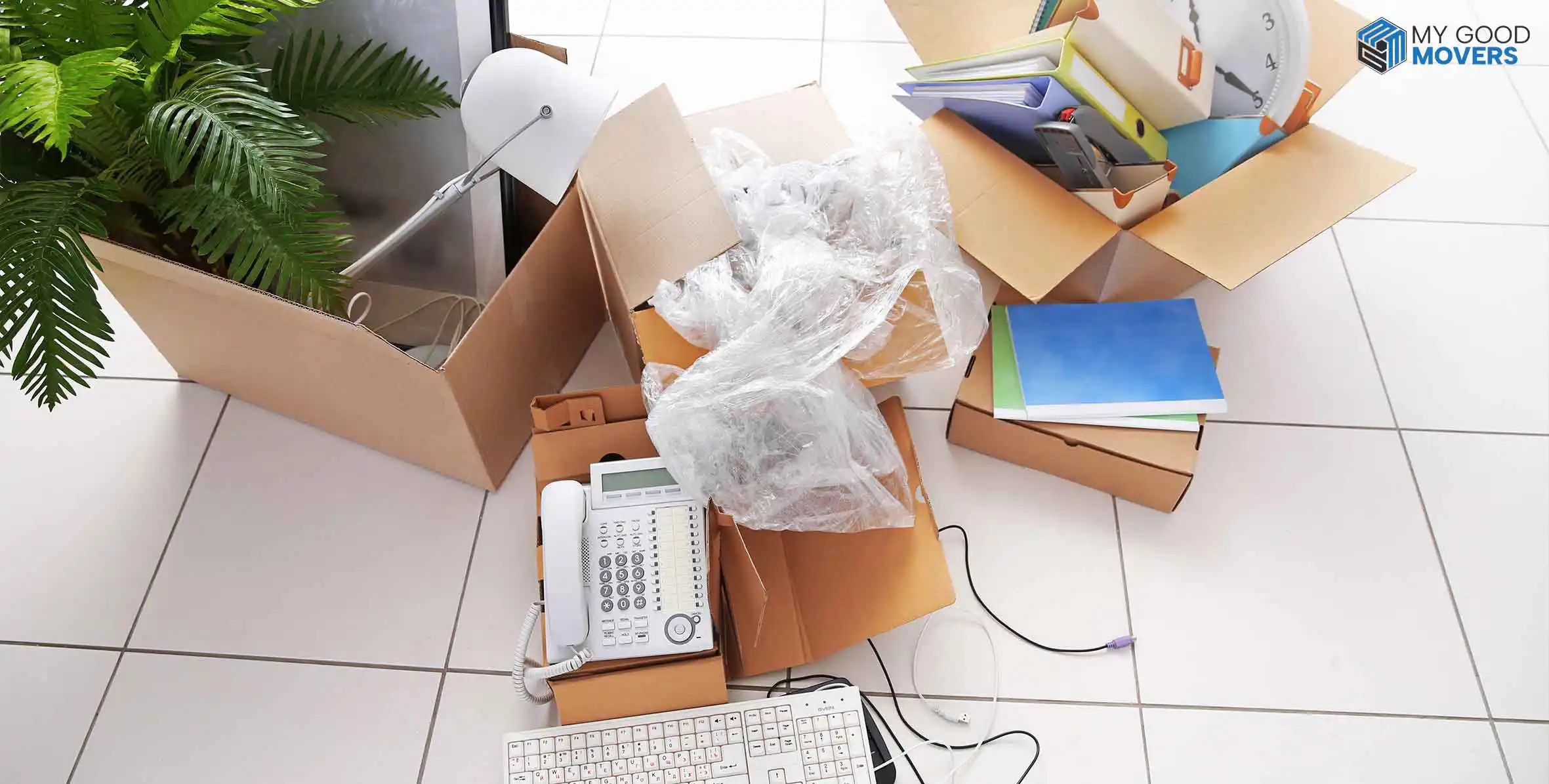Moving isn't just about carrying boxes from one place to another. It's about taking your life with you safely and securely.
We all know that modern life revolves around our gadgets – smartphones, laptops, TVs, gaming consoles, and countless other devices.
In fact, the average American household owns over 10 electronic devices, from personal computers to smart home gadgets.
With that much tech, it's no surprise that moving electronics can seem like a logistical nightmare.
According to a survey, about 25% of movers report that packing and protecting fragile electronics is one of the most stressful parts of the moving process.
Imagine this: You've packed your entire life into boxes, ready to start fresh in a new home. But then comes the dreaded task of packing your electronics.
The fear of something getting damaged — a broken TV screen, a laptop that doesn’t boot up, or a phone with a shattered screen — can be stressful.
And repairing or replacing those items can cost a fortune.
The cost of a high-end flat-screen TV can range from $500 to $2,500, while a new laptop could cost $1,000 or more.
That's a lot of money to risk just because the packing wasn't done right.
But don’t worry, this blog will guide you on "How to pack electronics for moving" so you can ensure that all your devices arrive safely at your new home.
Curious about your moving costs? Fill out the details, and we’ll calculate them for you.

Step 1: Back Up Your Data Before the Move
Before you begin packing your electronics, it’s essential to back up your data.
While it's possible to repair or replace your devices, recovering lost data is another story.
So, whether it's your laptop, tablet, or smartphone, make sure to back up all your important files.
Cloud Storage: Google Drive, iCloud, and Dropbox offer cloud storage options to save documents, photos, and other important data.
External Hard Drive: If you prefer physical backups, invest in a reliable external hard drive or SSD to back up your files.

Get an Instant Quote for Your Move __ Find the Best Moving Companies Near You.
Step 2: Gather the Right Packing Materials
When it comes to packing electronics for moving, the right packing materials make all the difference.
Using high-quality, sturdy packing materials ensures your electronics remain undamaged throughout the process.
Key Packing Materials You’ll Need:
Original Packaging: If you've kept the original boxes, this is the best way to pack your electronics. Manufacturers design these boxes specifically to protect devices during transit.
Sturdy Boxes: If you no longer have the original packaging, use strong, corrugated boxes. Make sure they are large enough to accommodate your devices but not too big so that they shift around.
Bubble Wrap is your best friend when packing electronics. Use bubble wrap to wrap your devices securely and protect them from shocks and bumps.
Packing Peanuts or Foam: To fill empty space inside boxes and prevent your electronics from moving around.
Antistatic Bags: To prevent static buildup on sensitive electronics like computer parts, use antistatic bags or wrap them in antistatic bubble wrap.

Need Professional Help Packing? __ Explore Top Moving Services and make sure your electronics are packed safely.
Step 3: Disconnect and Organize Cables and Accessories
Before packing your electronics, it's important to disconnect and organize all cables and accessories.
This not only makes your devices easier to pack but also makes setting them up in your new home much easier.
Label Cables: Label each cable with its corresponding device so that you don’t have to guess when it's time to set everything up.
Wrap Cables Neatly: Use Velcro strips or twist ties to bundle cables and prevent them from tangling.
Place Cables in Zip Bags: To keep your cables safe and organized, place them in labeled zip bags and keep them with their corresponding devices.
Why You Can Trust My Good Movers
130+
moving companies
listed
1,000+
customer reviews to help you decide
50+
states covered for moving services
100%
free quotes provided instantly
Step 4: Clean and Prepare Your Electronics for the Move
Dust and dirt can cause scratches and damage during the move, especially on screens and keyboards. So, it is compulsory to clean and prepare your electronics for the move.
Clean Screens: Wipe down your devices, especially the screens of laptops, TVs, and smartphones, with a microfiber cloth.
Vacuum Vents and Ports: Computers and other devices can collect dust in their vents, which can affect their performance. Use a soft brush or compressed air to clean out any dust or dirt from vents and ports.
Unplug and Power Down: Make sure all electronics are powered off and unplugged before packing them.
Step 5: How to Pack Your Electronics for Moving
Once you've backed up your data, gathered the necessary packing materials, organized cables, and cleaned your devices, you're ready to begin packing your electronics.
How to Pack Flat-Screen TVs
- Wrap the Screen: The screen of a TV is fragile, so wrap it in a soft blanket or foam padding to prevent scratches.
- Use a Sturdy Box: Place the TV in a sturdy box and make sure that there’s no room for it to shift inside. Fill any gaps with packing peanuts or foam for extra protection.
- Keep the TV Upright: When packing flat-screen TVs, always place them upright to avoid putting unnecessary pressure on the screen.

Packing Tips for a Smooth Move __ Read More About Packing Strategies.
How to Pack Laptops and Computers
- Use a Padded Sleeve: If possible, place your laptop in a padded sleeve. This adds an extra layer of protection.
- Wrap in Bubble Wrap: If you don’t have a sleeve, wrap your laptop in bubble wrap and place it in a sturdy box.
- Pack with Ample Cushioning: Add extra packing peanuts or foam to ensure the laptop does not move around in the box.
How to Pack Home Theater Systems and Speakers
- Wrap Each Component: For home theater systems, surround sound speakers, and other similar devices, wrap each piece in bubble wrap.
- Use a Large Box: Place each item into a large box and fill empty spaces with packing materials to prevent shifting.
Step 6: Label and Inventory Your Electronics
It’s essential to clearly label the boxes containing your electronics.
This helps movers handle them carefully and allows you to know exactly what’s inside each box.
Labeling: Write "Fragile" on the box, and if the contents need special handling (e.g., "This Side Up"), make sure those instructions are clearly visible.
Inventory: Make a list of all the electronics you are moving. This inventory will ensure nothing gets lost or misplaced during the move.
Step 7: Moving Electronics Safely
While you can do everything to pack them securely, it's just as important to handle them with care during the move.
Avoid Stacking Heavy Items: Do not place heavy items on top of electronic boxes, as this could cause crushing or internal damage.
Secure Devices in the Vehicle: If you’re moving the electronics yourself, make sure the boxes are securely fastened in your vehicle to prevent them from shifting.
Step 8: Unpacking and Setting Up Your Electronics
Once you’ve made it to your new home, it’s time to unpack and set up your electronics.
Check for Damage: As you unpack each device, check for any visible signs of damage. If there is any damage, document it and file an insurance claim if necessary.
Allow Electronics to Adjust to Temperature: If your electronics were exposed to extreme temperatures during the move, let them acclimate to the room temperature before turning them on.

Looking for a Reliable Moving Company? __ Get Free Moving Estimates.
What’s the Cost of Packing Supplies for Electronics?
When it comes to packing electronics for moving, one of the first things you'll want to think about is the cost of packing supplies.
The right materials can guarantee that your electronics arrive safely at your new home, but it’s also important to budget for them properly.
Here's a detailed look at the packing supplies you’ll need and their estimated costs.
| Packing Supplies | Estimated Cost (Low) | Estimated Cost (High) | Description |
|---|---|---|---|
| Original Boxes | $0 - $5 | $20 - $50 | If you have them, great! These offer optimal protection for your electronics. |
| Sturdy Corrugated Boxes | $1 - $3 | $5 - $10 | Durable boxes to hold and protect electronics during transport. |
| Bubble Wrap (Roll) | $10 - $20 | $20 - $50 | Provides cushioning and shock protection for fragile electronics. |
| Packing Peanuts | $5 - $15 | $15 - $25 | Filler material to prevent electronics from shifting around in boxes. |
| Antistatic Bags | $10 - $15 | $15 - $30 | Prevents static damage to sensitive electronics like hard drives and circuit boards. |
| Packing Paper | $5 - $10 | $10 - $20 | Wraps and fills empty spaces to prevent shifting of smaller electronics. |
| Packing Tape | $3 - $10 | $10 - $20 | Strong adhesive to seal your boxes securely and keep electronics safe. |
| Marker (for labeling) | $1 - $3 | $3 - $5 | Permanent marker for labeling boxes with contents and instructions like "Fragile" or "This Side Up." |
How Much Should You Budget?
So, how much should you expect to spend on packing your electronics?
On the Low End: If you already have some packing materials, like original boxes or some extra packing tape, you might spend as little as $40 to $80 for the essentials.
On the High End: For all new packing supplies, including bubble wrap, antistatic bags, and sturdy boxes, you’re likely looking at a range of $100 to $200 or more.
Note: While this may seem like a lot, it’s important to remember that investing in the right packing materials can prevent costly repairs or replacements. Plus, these supplies can often be reused for other moves or storage.
Additional Tips for Packing Electronics for a Move
Moving Electronics for Long Distance: Proper packing is even more crucial if you're moving across the country or internationally.
Use packing electronics for long-distance move tips, such as reinforcing boxes and opting for climate-controlled transport.
How to Pack Fragile Electronics: Be extra cautious when packing fragile electronics, such as cameras or delicate gadgets. Wrap each item with bubble wrap and place it in individual boxes.
Packing Electronics for International Move: If you're moving internationally, make sure your electronics are properly insured, and research any customs restrictions related to electronic items.
Recommended resources





